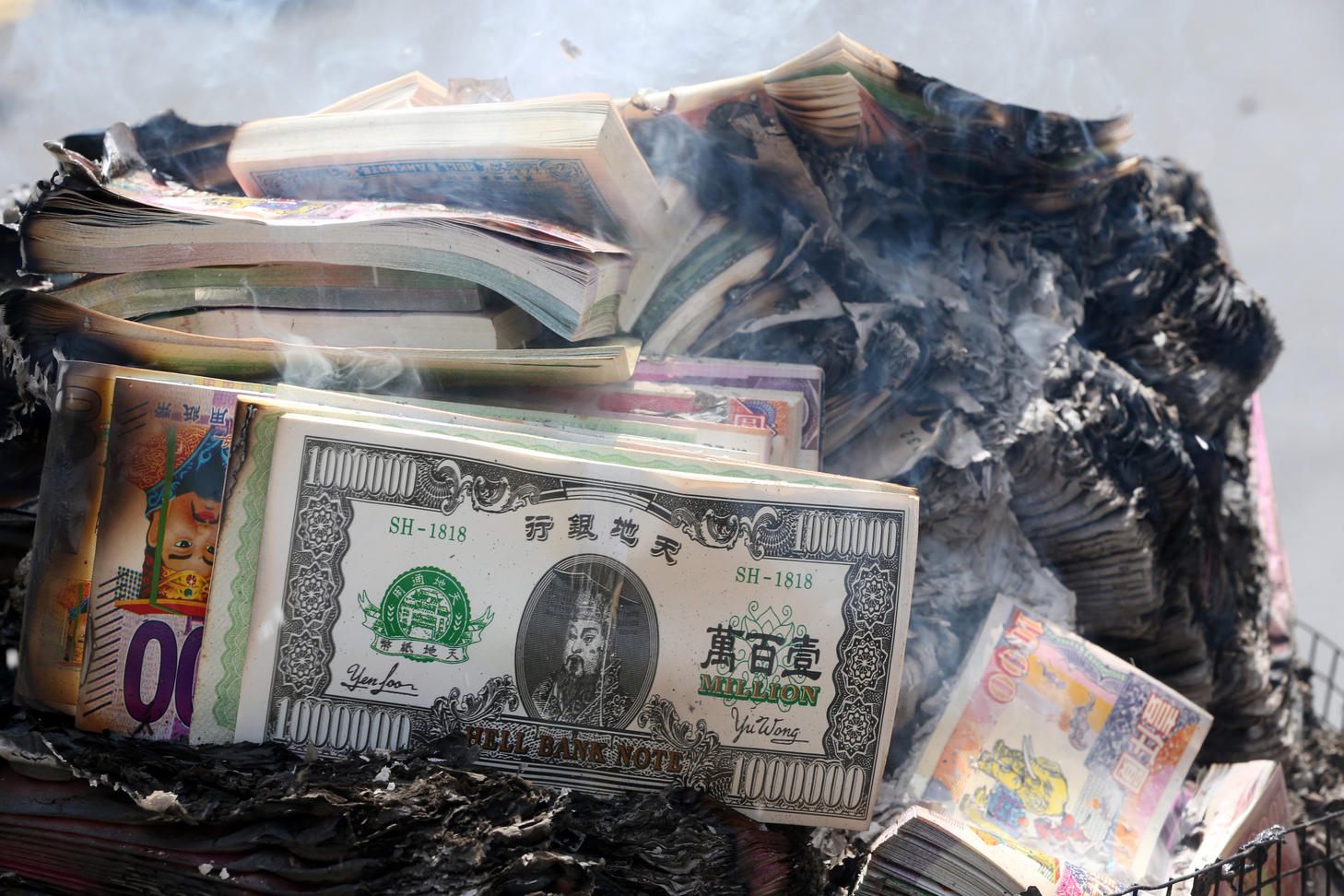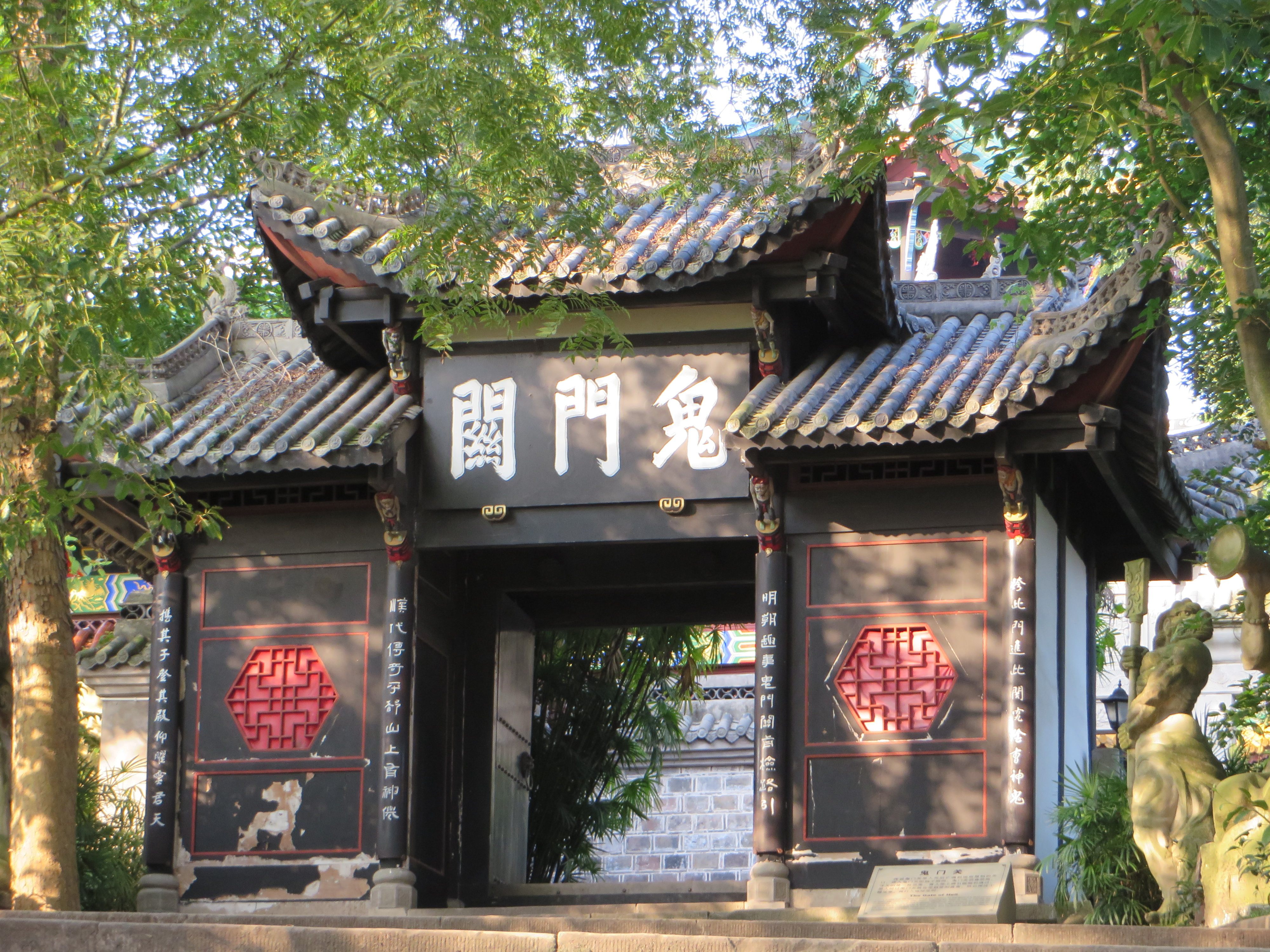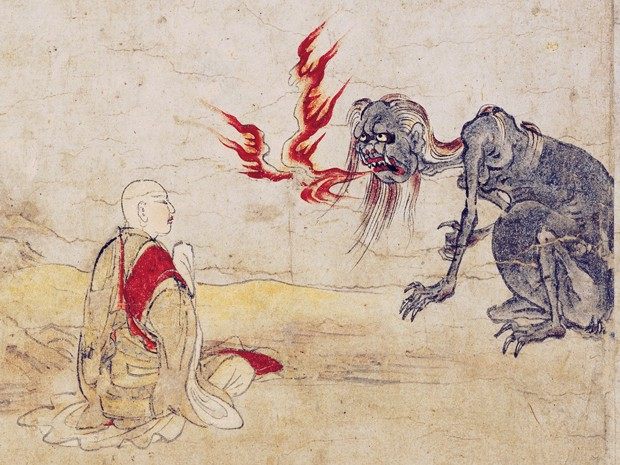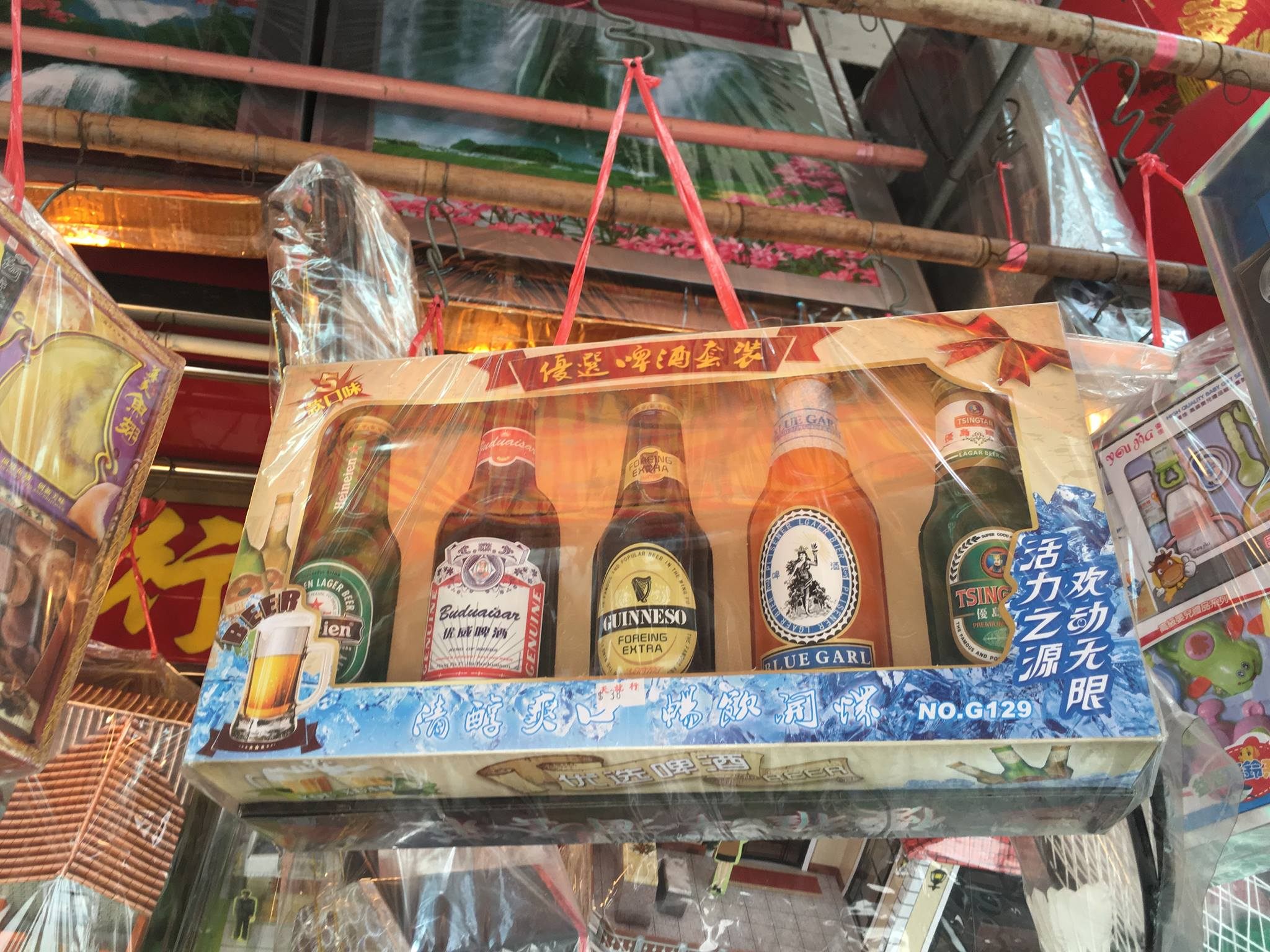In China, Ghosts Demand the Finer Things in Life
The Hungry Ghost Festival provides them with paper effigies of money, food—and iPhones.

There’s a pretty clear, well-defined set of traits that make up a ghost in the Western world—from the mushy green slimers of Ghostbusters to translucent, pudgy Casper to the myriad diaphanous denizens of Harry Potter’s Hogwarts. They’re immaterial, legless floaters that often care little for the material concerns of the living. It’s mostly a reflection of the Western conception of the afterlife, as place above (or below) the living world. But ghosts in other parts of the world can be rather different. In China, for example, ghosts experience the same desires and, quite literally, appetites of the living. And it’s in our best interests to give them what they want.
“The traditional view of death in China is different from the traditional view of death in the West,” says Nick Tackett, an historian from University of California, Berkeley, who studies traditional Chinese death rituals, especially those from Song and Liao periods. The spirit of the deceased separates into two parts, which one might call two souls. One of which resides—and ideally remains—in the tomb, and one of which resides in the ancestral tablet,” a plaque kept in shrines in homes or temples. After burial, souls need to be fed constantly, Tackett explains. “Regular offerings at the ancestral altar and periodic offerings at the grave helped satiate the souls of the deceased.”

But if something goes awry—forgetful relatives who neglect their feeding duties, an improper burial, or some unfinished business on Earth—a dead person’s soul can wander out of the tomb, hungry. These ghosts rarely meddle in the affairs of the living, but starting on the 15th day of the seventh month of the Chinese lunar calendar—roughly sometime in July/August—the gates of the underworld unlock, allowing flocks of hungry ghosts to roam freely for a month, the appropriately titled Ghost Month (鬼月), also known as the Yulan or Zhongyuan Festival.
The origins of this belief are thought to go back to a third-century tale about a Buddhist monk, Mulian, whose deceased mother came back to haunt him as a thin-throated, huge-stomached, ravenous apparition. Mulian desperately wanted to satisfy her, but he was unable. The more he fed her, the hungrier she became. It turns out she had been too greedy during her lifetime, leaving her insatiable in death. So the monk turned to Buddha for advice and learned that, on a particular auspicious day, he could visit the temple with food, money, and all sort of goodies to fill the ghost’s appetite. It worked, and the “Hungry Ghost” tradition was born.

Of course, the true origins of the ghost rituals are a little more complex. They developed out of a centuries-long process of mixing and matching of local folk traditions, Taoism, and Buddhism, dating to well before the third century. “Although the Ghost Festival is found only in East Asia in medieval times, many of its rituals and mythological components derive from lands to the West of China, not only India but the many kingdoms and trading centers of central Asia so crucial in the dissemination of Indic and Aryan culture to the east,” writes Stephen S. Teiser, a scholar of Buddhism and religion at Princeton University, in The Ghost Festival in Medieval China.
But Mulian’s tale is a significant part of the practice today. “Hungry ghosts are the spirits of people who always wanted more than they had, were never grateful for what they were given, and cannot find peace in the afterlife any more than they could when they lived,” according to writer Emily Mark in the Ancient History Encyclopedia. “They are often depicted as people with enormous stomachs but tiny mouths and necks which no amount of food could ever fill.”

On top of being rather hangry, these ghosts have some particular preferences during their month-long wandering on Earth. There is a long list of things that the living should avoid during Ghost Month. Whistling attracts ghosts. Leaving clothes out to dry tempts ghosts to try them on. Staying up late courts possession. Getting married or starting a relationship is a bad idea, as it is not likely to end well. And whatever you do, don’t buy a home or apartment during Ghost Month. It will be haunted forever. These beliefs actually have real life repercussions, as shown in a 2015 study by Agarwal Sumit and his colleagues at the National University of Singapore. During Ghost Month, they found, demand for housing goes down, which opens up good real estate deals for nonbelievers.

Now that you know what not to do, here’s what you should do to avoid the ire of hungry ghosts. Just like Buddha’s recommendations to Mulian, most of these rituals revolve around the provision of material goods. “There were numerous ways in which the dead seem to have benefited from a sort of ‘virtual reality,’” says Tackett. “Within the tomb, the soul of the deceased could enjoy an afterlife banquet represented in tomb murals. Similarly, fake paper money was as useful as real money.”
Archeological evidence suggests that paper offerings, known as zhizha, or “hell money,” date as far back as 1000 B.C. The idea is that through the act of burning, this fake money is transported to the underworld, where ghosts can squander it as they see fit. “It is implicitly agreed that if a person received proper burial and sacrifice, the ghost of this person will not come back to harm people,” writes Mu-chou Poo, a historian at the Chinese University of Hong Kong, in Rethinking Ghosts in World Religions. During the Song Dynasty (960–1279) other goods started to be made into a form of zhizha for ghost rituals. Paper effigies of clothes, houses, horses, and even servants were burned to send these items to the underworld’s lavish economy.

The desires of hungry ghosts have evolved with the times. “The festival, and the wider act of burning items to send to one’s ancestors in the underworld, reveals the cultural flows of globalization, and the consumption habits of individuals,” says Terence Hang, a sociologist at Singapore Institute of Technology who studies the festival’s visual culture. “Individuals now purchase and burn whatever is fashionable to consume in a contemporary, globalized society. One can get hold of paper iPads, paper credit cards, paper Rolls Royces, and more.”

“The idea is that you try to update their lifestyle to match your modern comfort,” says Xiaoxia Zhou from China Institute in America, a nonprofit organization that promotes Chinese culture. “Your ancestors should have the same things you have, read the same things you read. So people now burn paper TVs, paper fridges, [and] in some cases—taking female objectification to its extreme—even a beautiful mistress or a secretary.”
There was a moment when this centuries-long tradition seemed to be on its way out. It has long been tied the Chinese concept of filial piety (孝, xiao), which asserts that sons and daughters should take care of their parents the best they can. The 1911 revolution sought to do away with such ideas and practices. “Ghost Festival rituals or other manifestations of xiao were seens as backward folklore that was preventing China from modernizing,” says Zhou. Decades later, Mao Zedong, then a librarian, integrated this sentiment into his Cultural Revolution.

But the Ghost Festival was entrenched in Chinese culture. Not only has it survived, but now the Chinese government considers it part of the country’s intangible cultural heritage. Zhou explains that the tradition is strong in rural areas and southern provinces, but less so in China’s burgeoning urban centers. Some urban communities are now trying to make the centuries-old festival more relevant to young, Western-influenced city dwellers. In 2015 a community in Hong Kong launched the first Ghost Festival costume contest. “It can be just like Halloween,” Anven Wu Yim-chung, director at the Federation of Hong Kong Chiu Chow Community Organizations, told the South China Morning Post. The competition welcomed both traditional Chinese ghost options and anime characters. The 2016 edition added a ghost grappling competition and ghost opera.

And as the Hungry Ghost Festival loses some ground among the young, so does the centuries-long craft of making traditional zhizha paper effigies, which have been replaced by cheap, mass-produced versions available online rather than in traditional shops. But the ancient craft does endure. After graduating from design school in the early 1990s, Au Yeung Ping-chi decided to follow in his father’s footsteps and learn how to twist and turn thin sheets of bamboo paper to make evocative ghost effigies.
Ping-chi, who runs his workshop in Hong Kong’s Sham Shui Po district, made a name of himself as an “unconventional” effigy maker after he crafted a ghost guitar for the spirit of Koma Wong Ka-kui of renowned Hong-Kong rock band Beyond, who died after falling from a stage in Japan in 1993.

Since then he’s taken on a variety of commissions for unusual effigies, according to Zolima magazine: an Xbox, a skateboard, a nail clipper, a tamagotchi. Ghost food is another popular option. Ping-chi makes great ghost chicken wings and ghost dumplings. And the largest effigy he ever made was a full-scale fishing pole.
His father Wai-kin worries a bit about the direction the practice has taken. “The appearance of our effigies … have to be equivalent to what the living used, so the underworld can experience progress too,” he told the South China Post. “But some popular products now deviate from that principle.” One has to wonder what a hungry ghost would need an iPhone for anyway.






















Follow us on Twitter to get the latest on the world's hidden wonders.
Like us on Facebook to get the latest on the world's hidden wonders.
Follow us on Twitter Like us on Facebook